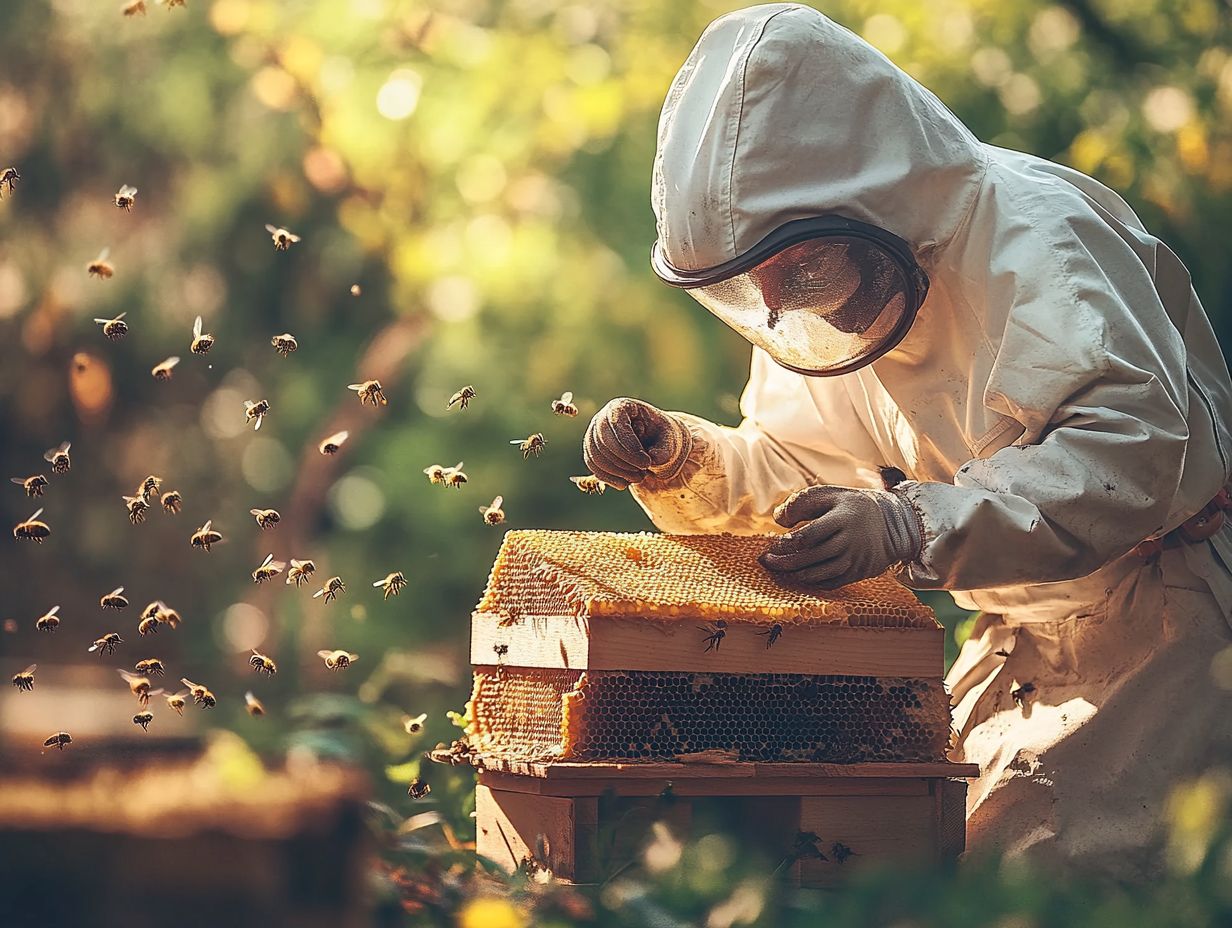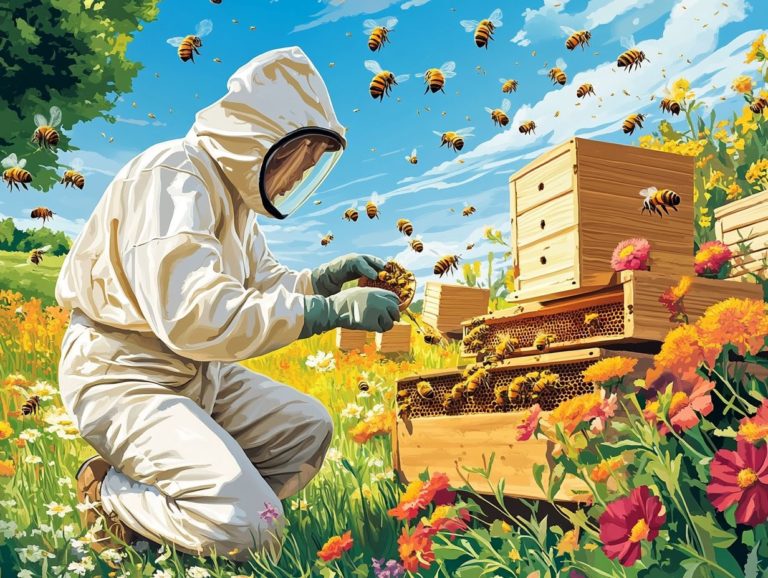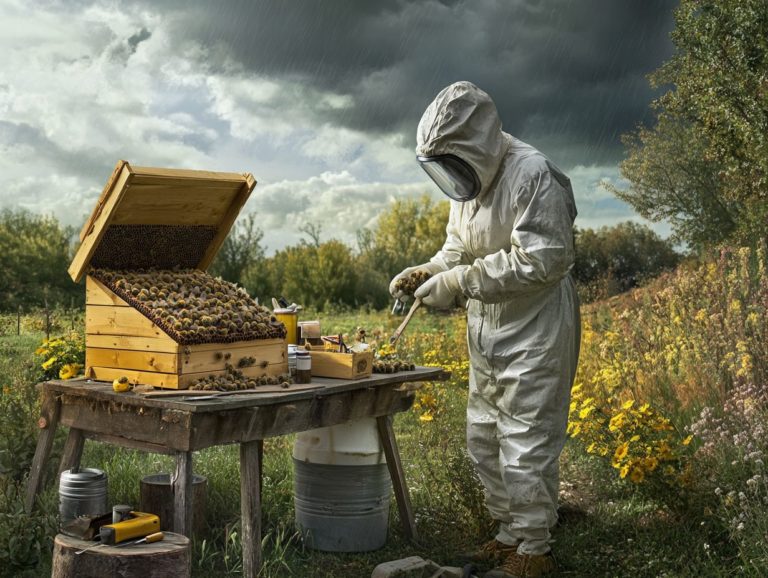Top Hive Management Strategies for Beekeepers
Effective hive management is essential for every beekeeper who aims to maintain healthy colonies, optimize honey production, and ensure sustainable pollination.
This article delves into vital strategies that encompass regular inspections, proper nutrition, swarm prevention, and pest and disease management.
Whether you’re an experienced apiarist or just embarking on your beekeeping adventure, grasping these key components will empower you to navigate the complexities of the craft and nurture thriving hives. This includes understanding swarming behavior and effective beekeeping practices.
Explore best beekeeping practices and insights on colony management that will elevate your beekeeping journey to new heights.
Contents
- Key Takeaways:
- 1. Regular Hive Inspections
- 2. Proper Feeding and Nutrition
- 3. Swarm Prevention Techniques
- 4. Pest and Disease Management
- 5. Queen Management
- 6. Adequate Ventilation
- 7. Maintaining a Clean and Organized Hive
- 8. Proper Harvesting Techniques
- 9. Monitoring Weather Conditions
- 10. Consistent Education and Training
- What Are the Key Components of a Hive Management Plan?
- Frequently Asked Questions
Key Takeaways:

- Consistent hive inspections help beekeepers identify and address potential issues, such as infestations of Varroa mites, before they become major problems. Varroa mites are tiny pests that can harm bee colonies.
- Proper nutrition, including the use of pollen substitutes and supplemental feeding, is crucial for a healthy and productive hive.
- Effective swarm prevention techniques, such as splitting hives and using swarm traps, can help prevent overcrowding and maintain a strong worker population.
1. Regular Hive Inspections
Regular hive inspections are essential to your success as a beekeeper. They ensure that your honey bee colonies flourish and maintain peak health throughout their seasonal lifecycle.
By closely monitoring your hive conditions, you can swiftly identify issues such as infestations of Varroa mites, assess bee nutrition, and implement best management practices that enhance colony survival and queen health.
Routine inspections also enable you to manage brood diseases, which affect bee larvae and pupae, effectively. Understanding environmental factors impacting honey bee health, such as outdoor temperatures, available nectar flow, and the effects of agricultural sprays, is crucial.
Engaging with apiary inspectors can provide you with invaluable insights during these evaluations, supporting your efforts in effective colony management.
To ensure optimal colony health, aim to conduct inspections every 7 to 10 days during the active season. This frequency allows you to track critical indicators of hive fitness, including brood patterns, the presence of diseases, and food stores.
Act quickly if you notice signs such as unusual bee behavior, excessive dead bees on the landing board, or a queen that isn t laying eggs consistently. Collaborating with apiary inspectors can elevate your evaluation process, as they bring specialized knowledge and can offer tailored recommendations based on local environmental conditions and specific challenges you may face as a beekeeper.
2. Proper Feeding and Nutrition
Ensuring proper feeding and nutrition for your honey bees is essential in maintaining a robust and thriving colony. This is especially important during lean times when nectar is scarce or throughout the winter months.
This vital aspect of beekeeping demands your careful attention to the dietary needs of these remarkable pollinators, which include a balanced mix of carbohydrates, proteins, vitamins, and minerals crucial for their well-being and colony strength.
One effective method you might consider is using sugar syrup, which can provide an immediate boost of carbohydrates when natural nectar is in short supply. Additionally, offering pollen substitutes can fulfill the protein needs necessary for brood rearing and sustaining winter bees.
By comprehensively understanding and implementing these supplemental feeding techniques, you can ensure that your colonies not only survive challenging conditions but truly thrive, enhancing their health and productivity throughout critical seasons.
Start implementing these strategies today to enhance your beekeeping skills and honey production!
3. Swarm Prevention Techniques
Implementing effective swarm prevention techniques is crucial for you as a beekeeper. This means inspecting for signs of overcrowding, like excessive honeycomb and limited space for the queen to lay her eggs.
By grasping the dynamics of bee populations, you can take proactive measures to ensure a stable environment for your hives. Regular hive maintenance is essential.
Managing your worker population through methods such as splitting hives or adding new frames can significantly alleviate overcrowding and reduce the chances of swarming. Practicing consistent and knowledgeable queen rearing is also key to preventing multiple queens from developing, which triggers swarming behavior.
Observe physical signs, such as the presence of queen cells and changes in worker bee behavior. This allows you to take immediate action to mitigate the risk of swarming and keep your hive thriving.
4. Pest and Disease Management

Pest and disease management is vital for your honey bees. Address threats like the Varroa mite early to protect your colony’s health.
These challenges threaten both the vitality of bee populations and the overall well-being of your colony. They also impact honey production levels, pollination contracts, and the economic stability of your beekeeping endeavors.
As a beekeeper, you are encouraged to adopt systematic monitoring techniques, such as regular inspections and mite counts, to identify infestations early. Treatment options might include organic acids, essential oils, and various pest management strategies.
Understanding pest control methods, along with the life cycles of these pests, helps you develop targeted approaches. Effective management enhances the resilience of your colonies, ensuring these vital pollinators continue to thrive.
5. Queen Management
Effective queen management is crucial for maintaining optimal hive conditions and ensuring a vigorous, productive colony. The queen’s health and genetic quality directly affect your hive’s overall strength.
A strong queen not only supports consistent brood rearing but also plays a significant role in gathering resources and defending against potential threats. Implement queen-rearing strategies that prioritize selective breeding practices, focusing on desirable traits like disease resistance and temperament.
Regularly monitor queen health to ensure these traits are maintained. Evaluate genetic quality by studying the queen s lineage and assessing the performance of her offspring under various conditions.
Watch for signs of a failing queen, such as decreased egg production or declining brood health. Nurturing a strong queen is your key to thriving colonies.
6. Adequate Ventilation
Adequate ventilation is essential for maintaining your hive, as it helps regulate temperature and humidity levels that impact honey bee health. It also helps prevent disease outbreaks by reducing moisture buildup.
Extreme outdoor temperatures make ventilation critical. Stagnant air within the hive can lead to moisture buildup, fostering an environment for mold and disease, adversely affecting your colony strength.
You should also consider installing screened bottom boards and upper ventilation entrances to enhance air circulation. Using a ventilation cloth can assist in maintaining optimal humidity levels.
Stay proactive with regular inspections to catch ventilation issues before they become a problem!
7. Maintaining a Clean and Organized Hive
Maintaining a clean and organized hive is crucial for effective hive management. It significantly enhances honey production and prevents disease outbreaks. Regular comb replacement is essential to prevent pathogen buildup.
A hygienic environment not only ensures that your bees thrive but also reduces the chances of pests like Varroa mites and wax moths invading the colony. Regularly replacing old comb is one of the best practices you can adopt, as old comb may harbor pathogens that compromise colony health.
By implementing sanitation measures, such as cleaning tools and equipment after each use, you minimize the risks of mixing germs from different sources. Using proper beekeeping equipment can also enhance hive security and overall colony strength.
An organized hive promotes efficiency, allowing your bees to work seamlessly. A clutter-free space enables you to monitor the colony’s health and productivity with greater ease.
8. Proper Harvesting Techniques

Mastering proper harvesting techniques can dramatically boost your honey yield while ensuring the sustainability of your colony and maintaining adequate honey stores for the bees.
To kick off the harvesting process, you should choose the right moment. Aim for a warm, dry day in late summer or early fall when nectar flow has tapered off, commonly known as the fall flow. This timing allows you to assess the honey frames more efficiently and ensures that the bees have enough food to get them through winter.
You ll want to gather some key tools for the job:
- Bee smoker to soothe the bees
- Hive tool to pry apart the frames
- Honey extractor to spin out the honey while keeping the bees’ wax intact
Proper usage of beekeeping resources and an understanding of hive conditions are also essential for an efficient harvest.
By understanding the behavioral patterns of your bees, you can easily locate the frames filled with honey. It s important to strike a balance between production and the bees’ nutritional needs, which means leaving enough honey in the hive to support the colony typically around 60 to 80 pounds. This way, both you and your bees can thrive in harmony.
9. Monitoring Weather Conditions
Monitoring weather conditions is essential for you as a beekeeper. Outdoor temperatures and environmental factors play a significant role in the seasonal lifecycle and foraging behavior of honey bees.
Temperature fluctuations can directly influence nectar flow and the timing of flower blooming, both of which are vital for the foraging success of your bees. Warmer temperatures often lead to earlier blooms, providing your bees with crucial food sources just when they ramp up their activity.
On the flip side, extended cold spells can delay blooming, forcing your bees to conserve energy and resources. To navigate these weather shifts effectively, you might need to adjust your management practices perhaps by offering supplemental feeding during unexpected cold snaps or relocating hives to areas with better floral availability.
By staying attuned to weather patterns, you can bolster the resilience of your colonies and ensure a thriving, productive beekeeping season.
10. Consistent Education and Training
Consistent education and training are essential for you as a beekeeper to stay updated on the latest practices and innovations that underpin successful beekeeping operations.
By participating in workshops and specialized courses, you can deepen your understanding of hive management, disease prevention, and sustainable practices. These invaluable educational opportunities, often offered by extension services, enable you to make informed decisions.
As you enhance your knowledge, you not only improve your efficiency in managing hives but also play a vital role in the health of pollinator populations.
This ongoing commitment to learning nurtures a community of informed apiarists, equipping you and your peers to face challenges like habitat loss and climate change, ultimately ensuring a vibrant ecosystem for generations to come.
What Are the Key Components of a Hive Management Plan?
A comprehensive hive management plan encompasses key components such as hive maintenance, colony management, bee nutrition, pest control, and effective queen management all essential for ensuring the health and productivity of your honey bee population.
Each of these elements plays a vital role in creating a thriving environment for your bees. For instance, conducting regular inspections and maintenance of your hives allows you to identify potential issues before they escalate. Additionally, colony management practices like monitoring brood patterns are crucial for understanding the growth dynamics of your colonies.
Meeting the nutritional needs of your bees involves providing access to a diverse array of foraging plants, enhancing their ability to produce honey and sustain the hive. Similarly, implementing robust pest control measures, such as targeted treatments for Varroa mites, is essential for safeguarding the health of your colony.
Effective queen management, which includes replacement strategies and requeening, is also critical for maintaining the vitality and productivity of your colonies. By focusing on these key areas, you can foster a flourishing beekeeping environment.
What Are the Most Common Challenges in Hive Management?

As a beekeeper, you encounter several common challenges in hive management, such as addressing pests and diseases, ensuring the health of your queens, and adapting to the ever-changing environmental factors that can impact your colony’s strength.
These hurdles can significantly influence honey production and the overall vitality of your colonies. To effectively tackle these issues, you should prioritize regular inspections to catch early signs of disease or pest infestations. Implementing integrated pest management strategies will also help you reduce reliance on chemical treatments. By staying informed about local climate conditions and seasonal changes, you can prepare and adjust your practices accordingly.
Proactively maintaining strong, healthy queens is essential, as they form the backbone of your colonies, ensuring resilience in the face of challenging conditions.
How Can a Beekeeper Prevent Swarming?
Preventing swarming is essential in your beekeeping journey, demanding your attention to swarming behavior, effective queen management, and the maintenance of optimal hive conditions to ensure your colony remains robust.
To tackle this concern effectively, you should regularly monitor your hives for early signs of swarming, such as the formation of queen cells. Keeping a vigilant eye on brood patterns and overall hive activity can help you identify potential issues before they escalate into serious problems. Adjusting hive space by adding supers or removing frames can relieve overcrowding, a common trigger for swarming.
Additionally, employing techniques to split colonies at the right time not only reduces the risk of swarming but also encourages population growth. By understanding the dynamics within your hive, you can foster a more stable environment, resulting in healthier colonies and bountiful honey yields.
What Are the Best Practices for Feeding Bees?
Understanding the best practices for feeding bees is crucial for ensuring that honey bees meet their nutritional requirements, particularly during times of scarcity or heightened demand.
These nutritional needs can shift due to seasonal changes, the availability of local flora, and the overall health of the hive. As a beekeeper, you have a variety of feeding options at your disposal to effectively support your colonies. For example, sugar syrup often serves as an emergency energy source during dearth periods when natural food sources dwindle. Preparing the syrup correctly is vital; a common ratio is one part sugar to one part water, gently heated to dissolve completely.
You might also consider introducing pollen substitutes to provide essential proteins that support brood rearing. Being able to recognize signs of nutritional deficiency like reduced brood development or increased bee mortality will enable you to intervene in a timely manner.
Regularly assessing your hive s needs will ensure that supplemental feeding is executed effectively, ultimately enhancing the overall health and productivity of your colony.
How Can a Beekeeper Identify and Treat Pests and Diseases?
Identifying and addressing pests and diseases is crucial for maintaining the health of your honey bees. Stay vigilant for signs of infestation, such as the notorious Varroa mite and common brood diseases.
Regularly monitoring your hives is key to catching these issues early. Make it a habit to examine your colonies for symptoms like abnormal brood patterns. Keep an eye out for signs of Varroa mites, which are often visible on adult bees or lurking in brood cells. Using sticky boards can greatly assist you in this task by trapping fallen mites and making it easier to assess the situation.
By ensuring proper hive management and upholding rigorous hygiene practices such as cleaning equipment and removing dead bees you can dramatically lower the chances of disease outbreaks. Treatment options can range from natural remedies to chemical interventions, but it s essential to adopt combined strategies to control pests. This holistic approach tackles current problems while fostering long-term bee health by reducing pest populations through sustainable practices.
What Are the Benefits of Regular Hive Inspections?
Regular hive inspections offer a wealth of benefits that enhance honey bee health, streamline colony management, and enable you to implement timely disease management strategies, ensuring the hive remains vibrant and thriving.
By routinely assessing the conditions of your hives, you can catch early signs of pests or diseases before they escalate into serious issues, thereby safeguarding the well-being of your colonies. These inspections contribute to healthier hives and boost overall colony productivity. You’ll identify which hives are thriving and which need a little extra care, allowing you to allocate resources efficiently.
As you monitor bee behavior during these inspections, you gain valuable insights into the hive’s dynamics, including foraging patterns and potential stressors that could affect honey production. Acting now creates a thriving environment for your bees, enhancing their resilience against challenges posed by their surroundings.
Frequently Asked Questions
What are the top hive management strategies for beekeepers?
1. Regular hive inspections help catch potential issues early and maintain healthy colonies.
2. Proper placement of hives: Strategic placement of hives, considering environmental factors, can improve foraging, reduce the risk of pests and diseases, and enhance colony survival.
3. Providing adequate food and water: Bees need access to a variety of food sources and clean water for their survival. Ensuring adequate bee nutrition and supplemental feeding, especially during nectar dearth, is crucial.
4. Controlling pests and diseases: Implementing pest and disease management techniques, such as using screened bottom boards and proper hive ventilation, can help keep your colonies healthy. Regular inspections for Varroa mite and brood diseases are essential for effective pest control and disease management.
5. Queen management: Regularly checking the health and productivity of your queen, including her genetic quality, and replacing her as needed can ensure the success of your hive. Implementing innovative hive management techniques is also vital for maintaining colony strength and honey production.
6. Seasonal management: Different seasons require different hive management strategies. Stay informed and adapt your practices accordingly, considering the seasonal lifecycle of honey bees. For instance, managing hive conditions during the fall flow and ensuring hive strength in preparation for winter bees are crucial for colony survival.
Ready to protect your bees? Start inspecting your hives today!





